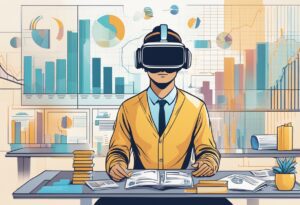The finance sector has always been at the forefront of innovation, and the emergence of virtual reality (VR) has opened up new avenues for the industry. VR is an immersive technology that allows users to experience a computer-generated environment as if they were physically present in that environment. The potential applications of VR in finance are vast, ranging from training and education to customer engagement and investment analysis. In this article you will learn about virtual reality in finance and 10 practical use cases of VR in the finance sector.
One of the most significant benefits of VR in finance is the ability to provide immersive training and education experiences. Finance professionals can use VR to simulate real-world scenarios, allowing them to practice and refine their skills in a safe and controlled environment. This can be particularly useful in high-pressure situations, such as trading floors or investment banking, where mistakes can be costly. VR can be used to provide customers with interactive and engaging educational experiences, improving financial literacy and building trust between financial institutions and their clients.
The Role of Virtual Reality in Financial Services
Virtual reality (VR) is a transformative technology that has the power to reshape the financial industry. It can create immersive experiences that enhance customer service, provide virtual trading and investment platforms, and offer financial education and training.
Enhancing Customer Experience
VR can provide customers with a personalized, face-to-face virtual environment that transforms traditional banking and financial services into staggering visual experiences.
This technology can help financial institutions show empathy with customers by making the experience more personal. VR can also be used to create virtual branches that allow customers to access services from anywhere in the world.
Virtual Trading and Investment Platforms
VR can be used to create virtual trading and investment platforms that provide users with a more immersive experience.
These platforms can simulate real-world market conditions, allowing users to test their investment strategies in a safe and controlled environment. VR can also be used to create virtual reality payment systems that enable users to make purchases without leaving the virtual world.
Financial Education and Training
VR can be used to provide financial education and training to customers and employees. This technology can create immersive training programs that simulate real-world financial scenarios, allowing users to practice their skills in a safe and controlled environment. VR can also be used to provide financial education to people who may not have access to traditional financial services.
VR has the potential to transform the financial industry by providing immersive experiences that enhance customer service, provide virtual trading and investment platforms, and offer financial education and training. Financial institutions can leverage VR technology to create personalized, engaging experiences that help them build stronger relationships with their customers.
10 Use case of virtual reality in finance

- Virtual branches and customer service
- Immersive data visualization
- Financial education and literacy programs
- Remote collaboration and meetings
- Virtual trading floors
- Simulated risk assessment scenarios
- Employee training and onboarding
- Real estate tours and mortgage visualization
- Wealth management and financial planning
- Enhanced cybersecurity training
Virtual Branches and Customer Service
Virtual branches are a revolutionary use case of virtual reality in finance, allowing customers to experience a full-service bank branch from the comfort of their homes.
By donning a VR headset, users can enter a virtual space where they can interact with tellers, explore financial products, and conduct transactions as if they were at a physical location. This use case is particularly applicable for individuals who are unable to visit a branch due to mobility issues, time constraints, or during situations like a pandemic when remote access becomes crucial.
Immersive Data Visualization
In finance, the ability to understand complex data sets is essential. VR provides an immersive environment where financial data can be visualized in three dimensions, allowing analysts and investors to interact with and understand intricate patterns and trends in a more intuitive way.
This application is especially useful for spotting correlations, outliers, and other significant features in large data sets that might be missed on a traditional two-dimensional chart.
Financial Education and Literacy Programs
Financial education is critical for ensuring that individuals make informed decisions about their money. VR can create engaging and interactive educational experiences that make learning about finance fun and memorable. For example, VR simulations can teach users about budgeting, investing, and the consequences of financial decisions in a controlled, risk-free environment, which is directly applicable to real-life financial planning and management.
Remote Collaboration and Meetings
VR enables remote teams in the financial sector to collaborate and meet as if they were in the same room. This use case is invaluable for global financial institutions that require frequent communication between employees in different locations. Virtual meeting rooms facilitate presentations, discussions, and collaborative work on financial models or documents, all within a VR environment that fosters a sense of presence and teamwork.
Virtual Trading Floors
Virtual trading floors replicate the high-energy environment of stock exchanges using VR. Traders can experience the hustle and bustle of the trading floor without being physically present, complete with real-time data and interactions with other traders. This can be a game-changer for remote traders or for educational purposes, where students can learn about market dynamics in a realistic setting.
Simulated Risk Assessment Scenarios
VR can simulate various financial risk scenarios, allowing analysts to test the resilience of financial strategies against different market conditions.
By immersing themselves in these scenarios, professionals can better understand potential outcomes and prepare more robust financial plans. This simulation is applicable in real-life risk management and strategic financial planning.
Employee Training and Onboarding
VR provides an interactive platform for training new employees in the financial sector. New hires can navigate through virtual environments that mimic real-world banking operations, learning about processes, compliance, and customer service without the risk of making mistakes that impact actual clients. This hands-on approach to training is directly transferable to the employees’ day-to-day tasks.
Real Estate Tours and Mortgage Visualization
VR technology allows potential homebuyers to tour properties virtually, which is particularly useful when physical viewings are not possible or convenient.
Moreover, VR can help visualize mortgage and financing options overlaid on the property tour, giving buyers a better understanding of the financial commitment involved. This direct application of VR can streamline the home buying process and improve customer satisfaction.
Wealth Management and Financial Planning
Wealth management services can benefit from VR by providing clients with a visual representation of their investment portfolios, retirement plans, and other financial products.
Clients can explore different scenarios and outcomes based on their investment choices in a virtual environment, leading to more informed decisions and a better understanding of the long-term impact of their financial strategies.
Enhanced Cybersecurity Training
In the financial sector, cybersecurity is of utmost importance. VR can be used to train employees on recognizing and responding to cyber threats in a realistic yet controlled environment. These simulations can include everything from phishing attempts to complex security breaches, providing employees with the experience and knowledge needed to protect sensitive financial data in real-life situations.
Technological Advancements in VR and Finance

Virtual Reality (VR) has been around for some time now, but it is only in recent years that it has started to gain traction in the finance industry. As a result, various technological advancements in VR have been made to ensure that it is a reliable and secure technology for financial transactions. In this section, we will explore some of the technological advancements that have been made in VR and finance.
AI and VR Integration
One of the most significant technological advancements in VR and finance is the integration of Artificial Intelligence (AI). AI has been used to enhance the VR experience for users in the finance industry.
AI algorithms have been developed to analyze financial data, which can be used to make informed decisions. AI has been integrated into VR to provide personalized financial advice to users.
Biometric Security in Financial Transactions
Another significant technological advancement in VR and finance is the use of biometric security in financial transactions. Biometric security is the use of unique physical characteristics, such as fingerprints or facial recognition, to verify the identity of an individual.
This technology has been integrated into VR to ensure that financial transactions are secure and reliable. Biometric security is more secure than traditional security methods, such as passwords or PINs, as it is much harder to fake an individual’s unique physical characteristics.
Voice Recognition for Enhanced Accessibility
Finally, voice recognition technology has been integrated into VR to enhance accessibility for users. Voice recognition technology allows users to interact with VR using voice commands, making it easier for individuals with disabilities to use VR technology. Voice recognition technology can be used to verify the identity of individuals during financial transactions, making it a reliable and secure technology for financial transactions.
VR technology has come a long way in recent years, and various technological advancements have been made to ensure that it is a reliable and secure technology for financial transactions. The integration of AI, biometric security, and voice recognition technology has made VR a more accessible and secure technology for users in the finance industry.
Adoption of VR by Major Financial Institutions

Virtual Reality (VR) technology has been increasingly adopted by major financial institutions to enhance customer experience and improve operational efficiency. This section highlights some of the case studies and investment in VR technology by banks.
Case Studies: Fidelity Labs and Mastercard
Fidelity Labs, the innovation arm of Fidelity Investments, has been exploring the use of VR technology to enhance customer experience. In 2017, they launched a VR prototype that allows customers to view their portfolio in a 3D environment. This allows customers to have a better understanding of their investments and make informed decisions. Fidelity Labs is also exploring the use of VR in financial education and training.
Mastercard has also been exploring the use of VR technology in the financial sector. In 2019, they launched a VR-based payment system that allows customers to make payments in a virtual environment. This technology aims to enhance the security of online payments and reduce fraud.
Investment in VR Technology by Banks
Many banks have been investing in VR technology to enhance their customer experience. For example, BNP Paribas introduced a VR app that allows retail banking users to access their account activity and transaction records in a VR environment. This technology aims to enhance the customer experience and provide a more personalized service.
Investment banks have also been exploring the use of VR technology in financial analysis and trading. For example, Goldman Sachs has been using VR technology to visualize financial data and identify trends. This technology aims to improve the efficiency of financial analysis and reduce the time taken to make investment decisions.
The adoption of VR technology by major financial institutions is a positive development that aims to enhance customer experience and improve operational efficiency. As the technology continues to evolve, it is expected that more banks will invest in VR technology to stay ahead of the competition.
Impact of VR on Financial Professionals and Investors
Virtual reality (VR) has revolutionized the way financial professionals and investors interact with financial data. This technology has made it easier for them to analyze, visualize, and communicate financial information. VR has brought about significant changes in the financial industry, and it has been widely adopted by finance professionals and investors.
Data Visualization and Decision-Making
One of the significant impacts of VR on finance professionals and investors is its ability to visualize financial data. VR provides a 3D environment that allows them to interact with financial data and analyze it in a more intuitive and immersive way. This technology enables investors to make well-informed investment decisions by providing them with a better understanding of complex financial data.
Collaboration and Communication in Virtual Spaces
VR technology has also improved collaboration and communication among finance professionals and investors. With VR, they can communicate and collaborate in a virtual space, regardless of their physical location. This technology has made it easier for finance professionals to work together on financial models, investment strategies, and other financial projects.
Moreover, VR has made it possible for investors to attend virtual meetings and conferences, which can save them time and money. This technology enables them to interact with other investors, finance professionals, and industry experts from all over the world.
VR has transformed the financial industry by providing finance professionals and investors with a more intuitive and immersive way to analyze, visualize, and communicate financial data. This technology has made it easier for them to collaborate and communicate with each other, regardless of their physical location. VR has brought about significant changes in the financial industry, and it is expected to continue to shape the future of finance.

Future Prospects of Virtual Reality in Finance
Virtual Reality (VR) technology has been making significant strides in various industries, including finance. Emerging trends in the finance sector indicate that VR technology has the potential to revolutionize the industry, providing new opportunities for innovation and growth.
Emerging Trends and Potential Applications
VR technology has the potential to transform the way financial institutions operate. With the use of VR, financial institutions can create immersive experiences that enable customers to interact with financial products and services in a more engaging and personalized way.
VR can be used in the investment portfolio and retirement planning sectors to create virtual simulations that enable investors to visualize different investment scenarios and make informed decisions.
Furthermore, VR technology can be used to enhance insurance products by creating virtual scenarios that enable customers to better understand the benefits of different insurance products. This technology can also help financial institutions to create more effective training programs for their employees by providing immersive simulations that replicate real-world scenarios.
Challenges and Considerations for Implementation
Despite the potential benefits of VR technology, there are challenges and considerations that financial institutions need to address before implementing this technology. One of the primary concerns is cybercrime. Financial institutions need to ensure that their VR systems are secure and that customer data is protected from cyber threats.
Another challenge is the cost of implementing VR technology. Financial institutions need to consider the cost of hardware, software, and maintenance when implementing VR systems. Financial institutions need to ensure that their employees are trained to use the technology effectively.
VR technology has the potential to transform the finance industry by providing new opportunities for innovation and growth. While there are challenges and considerations that financial institutions need to address, the potential benefits of VR technology make it an exciting prospect for the future of finance.
Frequently Asked Questions
What are some practical applications of virtual reality in the financial sector?
Virtual reality technology has numerous practical applications in the financial sector. One of the most significant applications is in financial data visualization and analysis. Virtual reality provides a more immersive and intuitive way of visualizing complex financial data, allowing analysts to identify trends and patterns more easily. Virtual reality can be used for training and development in the banking industry, enabling employees to practice real-life scenarios in a safe and controlled environment.
Which companies are leading the integration of virtual reality into financial services?
Several companies are leading the integration of virtual reality into financial services. D6 VR, a subsidiary of The Glimpse Group, specializes in 3D data visualization and has been a pioneer in this area. Other companies, such as Talespin and INTRUST Bank, are using virtual reality for training and development purposes.
How is augmented reality enhancing the customer experience in banking?
Augmented reality is enhancing the customer experience in banking by providing a more immersive and interactive way of engaging with financial products and services. For example, some banks are using augmented reality to create virtual branches, allowing customers to interact with bank representatives and access financial information from the comfort of their own homes.
In what ways is virtual reality technology impacting FinTech innovation?
Virtual reality technology is impacting FinTech innovation in several ways. For example, it is enabling the development of more immersive and interactive financial products and services, such as virtual trading platforms. Virtual reality is providing a more intuitive way of visualizing complex financial data, allowing FinTech companies to gain deeper insights into customer behavior and market trends.
Can virtual reality be used for training and development in the banking industry?
Yes, virtual reality can be used for training and development in the banking industry. Virtual reality provides a safe and controlled environment for employees to practice real-life scenarios, enabling them to develop the skills and knowledge needed to succeed in their roles. Virtual reality training can be customized to meet the specific needs of individual employees, ensuring that they receive the most relevant and effective training possible.
What are the benefits of virtual reality for financial data visualization and analysis?
Virtual reality provides several benefits for financial data visualization and analysis. It allows analysts to visualize complex financial data in a more immersive and intuitive way, enabling them to identify trends and patterns more easily. Virtual reality can provide a more collaborative and interactive way of analyzing financial data, allowing analysts to work together more effectively and share insights more easily.




